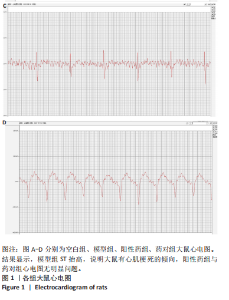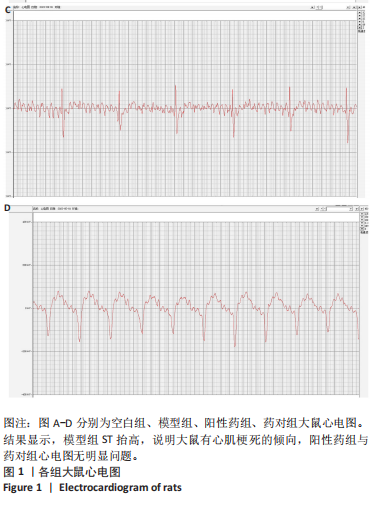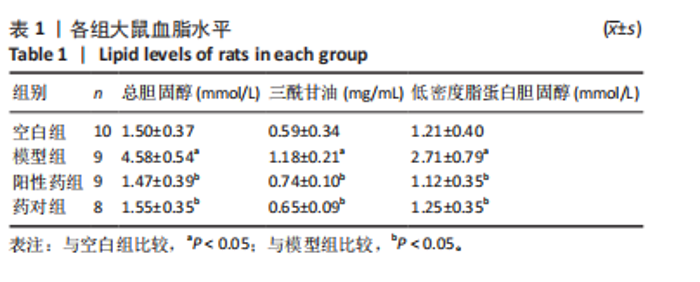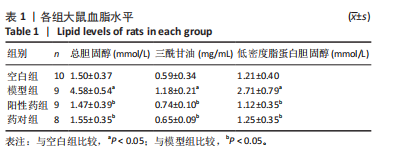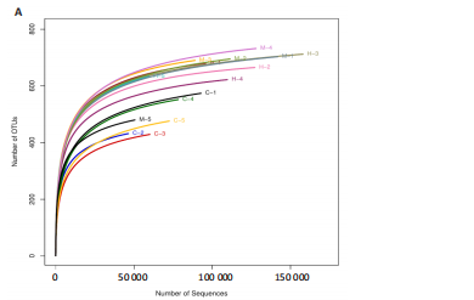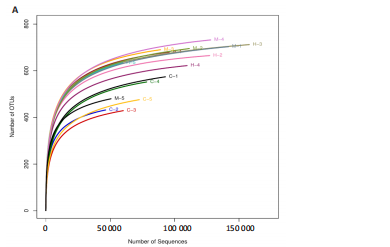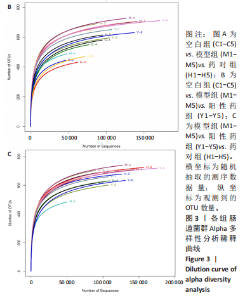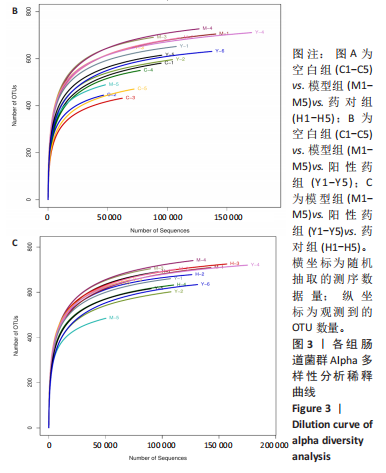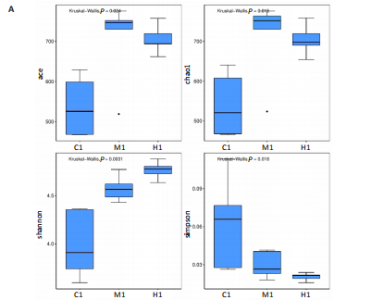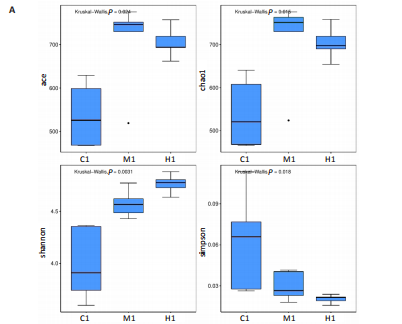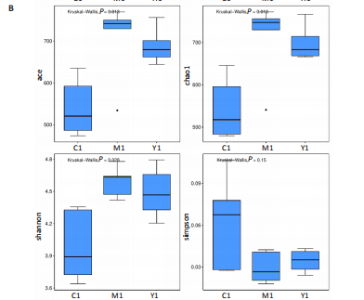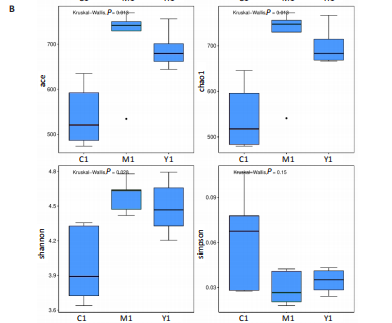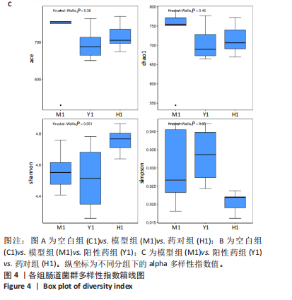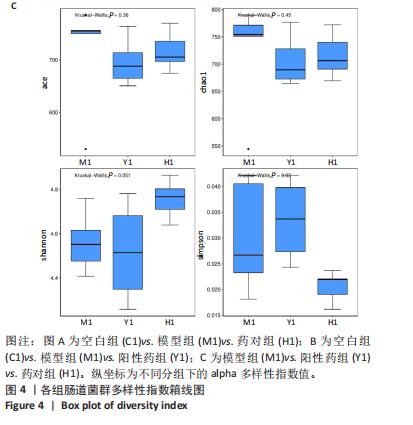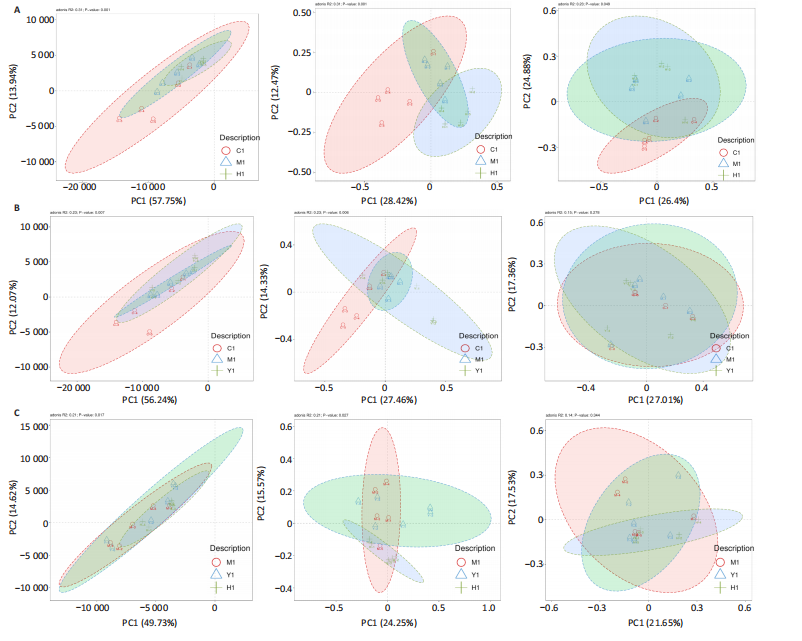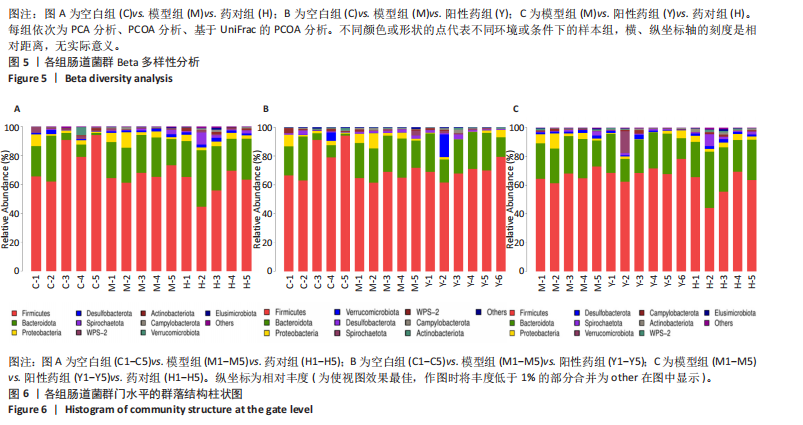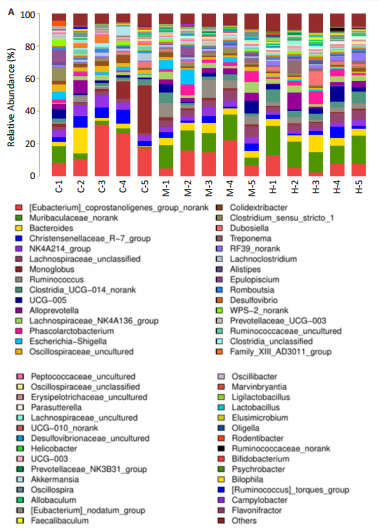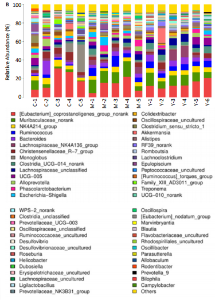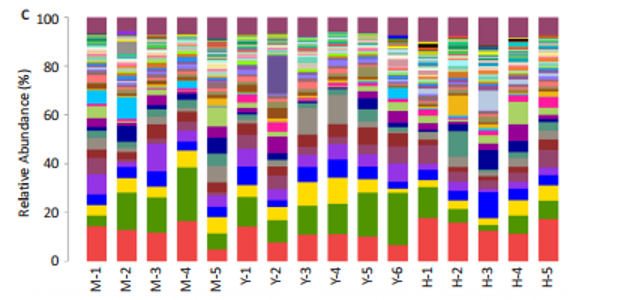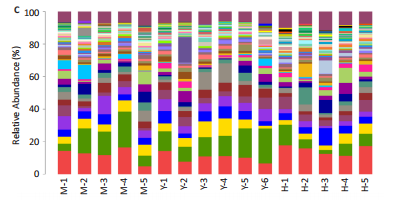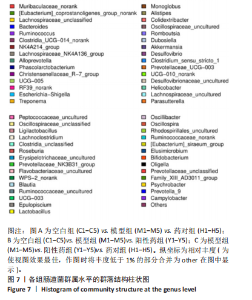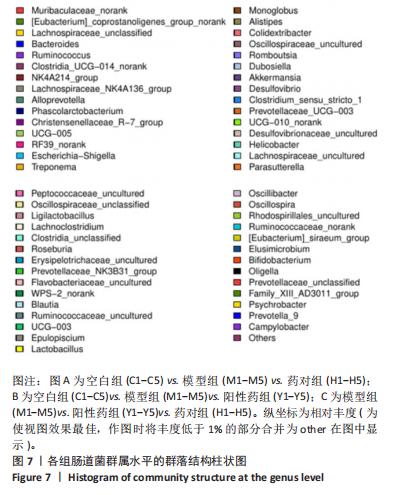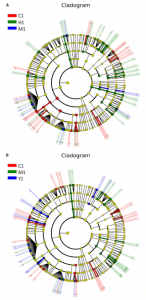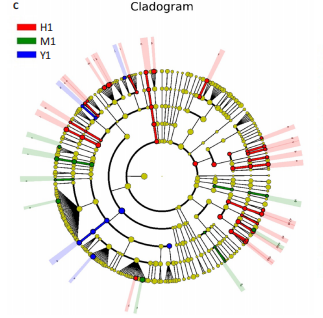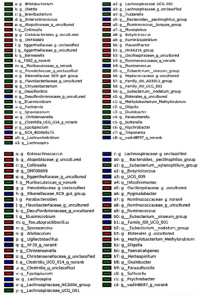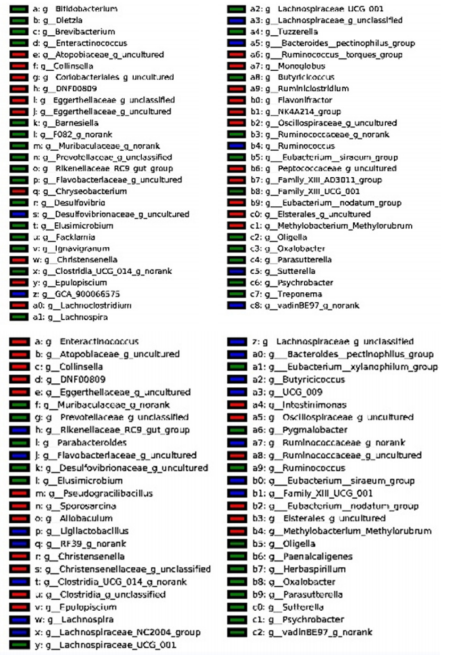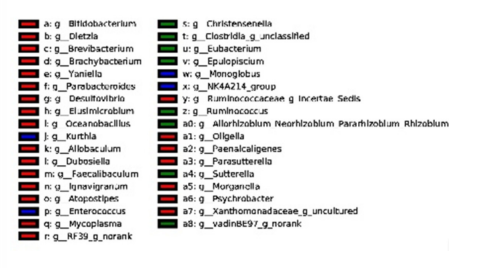Chinese Journal of Tissue Engineering Research ›› 2025, Vol. 29 ›› Issue (5): 917-927.doi: 10.12307/2025.236
Previous Articles Next Articles
Therapeutic effect and mechanism by which Trichosanthis Fructus-Allii Macrostemonis Bulbus regulates gut microbiota in a rat model of coronary heart disease #br#
#br#
Sun Guanghan1, Xie Zhencong1, Sun Mi2, Xu Yang3, Guo Dong2
- 1The First Clinical Medical College of Shandong University of Traditional Chinese Medicine, Jinan 250014, Shandong Province, China; 2Teacher Development Center, 3Institute of Pharmacy, Shandong University of Traditional Chinese Medicine, Jinan 250355, Shandong Province, China
-
Received:2024-01-16Accepted:2024-02-08Online:2025-02-18Published:2024-06-01 -
Contact:Guo Dong, MD, Professor, Chief physician, Doctoral supervisor, Teacher Development Center, Shandong University of Traditional Chinese Medicine, Jinan 250355, Shandong Province, China Co-corresponding author: Xu Yang, MD, Lecturer, Institute of Pharmacy, Shandong University of Traditional Chinese Medicine, Jinan 250355, Shandong Province, China -
About author:Sun Guanghan, MD candidate, The First Clinical Medical College of Shandong University of Traditional Chinese Medicine, Jinan 250014, Shandong Province, China -
Supported by:Key Discipline Program of the National Administration of Traditional Chinese Medicine, No. 220254 (to GD)
CLC Number:
Cite this article
Sun Guanghan, Xie Zhencong, Sun Mi, Xu Yang, Guo Dong. Therapeutic effect and mechanism by which Trichosanthis Fructus-Allii Macrostemonis Bulbus regulates gut microbiota in a rat model of coronary heart disease #br#
share this article
Add to citation manager EndNote|Reference Manager|ProCite|BibTeX|RefWorks
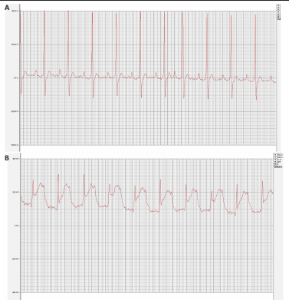
2.1 实验动物数量分析 选取SD大鼠40只进行实验,造模过程共死亡4只,其中2只死于麻醉意外,2只死于肠胀气,进入结果分析共36只。 2.2 各组大鼠一般状况及心电图监测结果 空白组大鼠状态良好,毛色洁白有光泽;与空白组比较,模型组大鼠精神萎靡、毛发黯淡、食欲不振;与模型组比较,阳性药组和药对组大鼠精神状态显著改善,毛色略有光泽,食欲增加,较为活跃。心电图监测,发现模型组ST抬高,说明大鼠有心肌梗死的倾向;阳性药组与药对组心电图无明显问题。见图1。 2.3 各组大鼠血脂水平 与空白组相比,模型组总胆固醇、三酰甘油、低密度脂蛋白胆固醇水平均显著增高(P < 0.05);与模型组相比,阳性药组、药对组总胆固醇、三酰甘油、低密度脂蛋白胆固醇水平均显著下降(P < 0.05);阳性药组与药对组各指标相比差异不显著。见表1。 2.4 大鼠心肌组织病理形态 空白组心肌细胞排列整齐,边界清楚,细胞呈细长的圆柱形,横纹清晰,胞浆红染均质,细胞核居中,圆形或椭圆形;模型组心肌细胞走行紊乱,边界欠清晰,间质见淋巴细胞浸润,局灶心肌细胞坏死,细胞核固缩,胞浆嗜酸性;阳性药组、药对组部分心肌细胞走行紊乱,边界欠清晰,间质见少量淋巴细"
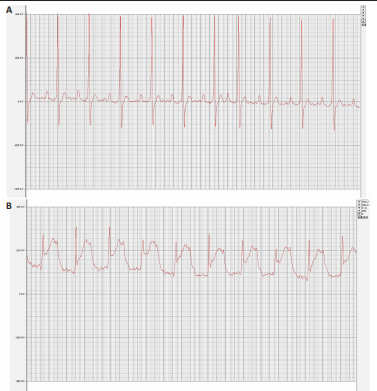
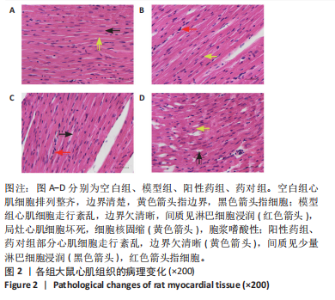
胞浸润,细胞呈细长的圆柱形,横纹清晰,胞浆红染均质,细胞核圆形或椭圆形,各细胞形态较模型组排列整齐,边界清楚。见图2。 2.5 Alpha多样性分析 各组稀释曲线逐渐趋于平缓,说明测序数据量合理,更多的数据量只会产生少量新的OUT,见图3。Alpha多样性主要评价肠道菌群丰富度和多样性。此次研究采用Ace指数、Shannon指数和Chao指数综合评价各组肠道菌群丰富度和多样性。 分别对 Alpha diversity 的各个指数进行参数检验和非参数检验分析(样品比较则分别使用R中的 kruskal.test 函数和anova函数),通过参数检验和非参数检验筛选不同条件下的显著差异的Alpha Diversity指数。与空白组比较,模型组、药对组的Ace、Shannon、Chao指数升高 (P < 0.05),Simpson指数降低(P < 0.05),见图4A;与空白组比较,模型组、阳性药组的Ace、Shannon、Chao指数升高(P < 0.05),Simpson指数降低(P < 0.05),见图4B。与模型组比较,阳性药组、药对组的Ace、Chao指数降低 (P < 0.05),Shannon指数无差异(P > 0.05),Simpson指数降低(P < 0.05),见图4C。 2.6 Beta多样性分析 通过分析不同样本OTU(97%相似性)组成可以反映样本间的差异和距离,PCA运用方差分解,将多组数据的差异反映在二维坐标图上,坐标轴取能够最大反映方差值的两个特征值。如样本组成越相似,反映在PCA图中的距离越近。 PCOA分析,用来研究样本群落组成的相似性或差异性,各组内样本相对聚集,表明组内差异较小,而各组间样本距离较远,表明各组间菌群构成具有明显差异,见图5。 2.7 肠道菌群落结构分析 在分类学分析结果中,包含样本中含有何种微生物和各微生物的相对丰度。在门水平包括梭状芽孢杆菌门(Clostridia)、Bacilli、γ-变形菌门(Gammaproteobacteria)、Negativicutes、放线菌门(Actinobacteria)、厚壁菌门(Firmicutes)、疣微菌门(Verrucomicrobiota)、WPS-2、脱硫杆菌门(Desulfobacterota)、螺旋菌门(Spirochaetota)、变 形 菌 门(Proteobacteria)、拟杆菌门(Bacteroidota)12种优势菌门。与空白组相比,模型组Desulfovibrionia、Spirochaetia、Gammaproteobacteria、Negativicutes、Bacteroidia、Proteobacteria相对丰度升高,Clostridia、Verrucomicrobiae、Bacilli、WPS-2_norank、Firmicutes、Actinobacteria相对丰度降低。与模型组相比,药对组WPS-2_norank、Desulfovibrionia、Actinobacteria、Spirochaetia、Bacteroidia、Bacilli相对丰度升高,Clostridia、Gammaproteobacteria、Negativicutes、Verrucomicrobiae相对丰度降低。与模型组相比,阳性药组Desulfobacterota、Spirochaetota、Verrucomicrobiota、Bacteroidota相对丰度升高,Firmicutes、Proteobacteria、WPS-2相对丰度降低。与阳性药相比,药对组Desulfobacterota、Actinobacteriota、Proteobacteria、Spirochaetota、Bacteroidota相对丰度升高,Firmicutes、Verrucomicrobiota相对丰度降低。见图6。 粪杆菌真核菌群([Eubacterium]_coprostanoligenes_group)、Muribaculaceae_norank、拟杆菌属(Bacteroides)、未分类的毛螺菌属(Lachnospiraceae_unclassified)、 Ruminococcus、Clostridia_UCG-014_norank(相对丰度值> 4%)为空白组肠道菌群在属水平上的主要构成。与空白组相比,模型组Muribaculaceae_norank相对丰度升高,[Eubacterium]_coprostanoligenes_gro成up_norank、Bacteroides相对丰度降低。与模型组相比,药对组Muribaculaceae_norank、Bacteroides相对丰度升高,[Eubacterium]_coprostanoligenes_group_norank相对丰度降低。与模型组相比,阳性药组[Eubacterium]_coprostanoligenes_group_norank相对丰度升高,Muribaculaceae_norank相对丰度降低。与阳性药组相比,药对组Bacteroides、Clostridia_UCG-014_norank、Muribaculaceae_norank相对丰度升高,[Eubacterium]_coprostanoligenes_group_norank、Ruminococcus、Lachnospiraceae_unclassified相对丰度降低,见图7。 2.8 肠道菌群组间差异分析 LEfSe采用线性判别分析(LDA)来估算每个组分(物种)丰度对差异效果影响的大小。结果发现:共29条差异显著的种群(LDA值> 4),其中12条富集于空白组,15条富集于药对组,2条富集于模型组,见图8A;共16条差异显著的种群(LDA值> 4),其中10条富集于空白组,7条富集于阳性药组,4条富集于模型组,见图8B;共18条差异显著的种群(LDA值> 4),其中6条富集于阳性药组,10条富集于药对组,2条富集于模型组,见图8C。"
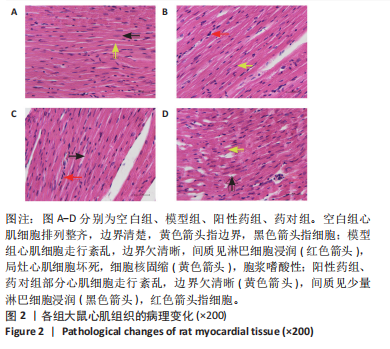
| [1] 中国心血管健康与疾病报告编写组.中国心血管健康与疾病报告2022概要[J].中国循环杂志,2023,38(6):583-612. [2] 王传池,许伟明,江丽杰,等.11383例健康人群及冠心病不同阶段患者痰瘀互结证分布规律的多中心横断面研究[J].中医杂志, 2021,62(6):494-504. [3] 李洪雷,王媛,刘彩红,等.瓜蒌薤白半夏汤本原剂量与现代剂量对痰浊壅塞证大鼠心肌梗死后心功能的影响[J].中华中医药杂志, 2019,34(11):5388-5391. [4] 尚菊菊,刘红旭,李享.基于指南/共识探讨中医/中西医结合防治冠心病的诊疗进展[J].北京中医药,2023,42(9):939-942. [5] 俞赟丰,张紫怡,唐佩,等.基于《胸痹心痛古今名家验案全析》的近现代名医论治心绞痛的用药规律研究[J].中药新药与临床药理,2021,32(9):1406-1411. [6] 苏伟,高枫,周春刚,等.瓜蒌薤白半夏汤对痰浊闭阻型不稳定型心绞痛患者血浆MMP-9和TIMP-1水平的影响[J].时珍国医国药, 2016,27(4):890-892. [7] 丁晓,吕玉婷,滕晶,等.“系统辨证脉学”指导下瓜蒌薤白半夏汤加减证脉象特征及应用举隅[J].中华中医药杂志,2017,32(10): 4514-4516. [8] 孙孟艳,秦合伟,牛雨晴,等.基于“心-小肠-脾”轴探讨肠道微生态失衡与动脉粥样硬化的关系[J].中国中医基础医学杂志,2024,30(4):654-658. [9] Bui TVA, Hwangbo H, Lai Y, et al. The Gut-Heart Axis: Updated Review for The Roles of Microbiome in Cardiovascular Health. Korean Circ J. 2023;53(8):499-518. [10] 王青,刘彦汶,于晓彤.仝小林治疗糖尿病性心脏病经验[J].辽宁中医杂志,2019,46(6):1164-1166. [11] Yan LL, Zhang WY, Wei XH, et al. Gualou Xiebai Decoction, a Traditional Chinese Medicine, Prevents Cardiac Reperfusion Injury of Hyperlipidemia Rat via Energy Modulation. Front Physiol. 2018;9:296. [12] 邵义祥.医学实验动物学教程[M].南京:东南大学出版社,2016:224. [13] 何彦虎,金华,刘志军,等.基于“心合小肠”理论探讨肠道菌群是冠心病干预的新靶点[J].中国微生态学杂志,2022,34(12): 1461-1466. [14] 孙静,刘赫昆.基于“心与小肠相表里”的冠心病与肠道微生态的关系探讨[J].时珍国医国药,2021,32(10):2482-2485. [15] 杨开燕,魏惠平,王记,等.基于肠心轴学说探讨肠道菌群在心血管疾病中的作用[J].中国现代应用药学,2023,40(24):3467-3472. [16] 程艳,张苗苗,国嵩,等.“心与小肠相表里”理论的历史源流及发展脉络[J].中医杂志,2023,64(13):1302-1307. [17] 陆晓江.对心绞痛、心肌梗塞的辨证论治[J].现代康复,1998,2(6): 44-45. [18] 吴珊,王传池,林明欣,等.近30年中医药治疗冠心病痰瘀互结证用药概况分析[J].中医杂志,2022,63(17):1685-1690. [19] 薛紫鲸,陈光,张丹,等.经典名方中瓜蒌与天花粉的本草考证[J].中国实验方剂学杂志,2023,29(17):62-74. [20] 汪冶,文惠玲.薤白的本草考证[J].中国中药杂志,1991,16(7): 389-390+446. [21] Chen M, Men L, Wu H, et al. A systematic review of the effectiveness and safety of Chinese herbal medicine formula Gualou Xiebai Banxia (GLXBBX) decoction for the treatment of stable angina pectoris.Medicine (Baltimore). 2019;98 (51):e18375. [22] Zhang YY, Zhao ZD, Kong PY, et al. A comparative pharmacogenomic analysis of three classic TCM prescriptions for coronary heart disease based on molecular network modeling. Acta Pharmacol Sin. 2020;41(6):735-744. [23] Zhang F,Duan B,Zhou Z, et al.Integration of metabolomics and transcriptomics to reveal anti-chronic myocardial ischemia mechanism of Gualou Xiebai decoction. J Ethnopharmacol. 2022;297:115530. [24] Yu YD, Hou WJ, Zhang J, et al. Network Pharmacology and Molecular Docking-Based Analysis on Bioactive Anticoronary Heart Disease Compounds in Trichosanthes kirilowii Maxim and Bulbus allii Macrostemi. Evid Based Complement Alternat Med. 2021; 2021:6704798. [25] Jia Z, Mei J, Zhang Y, et al. Whole genome methylation combined with RNA-seq reveals the protective effects of Gualou-Xiebai herb pair in foam cells through DNA methylation mediated PI3K-AKT signaling pathway. Front Immunol. 2023;14:1054014. [26] Xu J, Yang Y. Implications of gut microbiome on coronary artery disease. Cardiovasc Diagn Ther. 2020;10(4):869-880. [27] 杨雅萌.他汀类降脂药物对心内科疾病治疗的影响[J].中国医药工业杂志,2023,54(9):1398-1399. [28] Sun L, Jia H, Li J, et al. Cecal Gut Microbiota and Metabolites Might Contribute to the Severity of Acute Myocardial Ischemia by Impacting the Intestinal Permeability, Oxidative Stress, and Energy Metabolism.Front Microbiol. 2019;10(0):1745. [29] Sawicka-Smiarowska E, Bondarczuk K, Bauer W, et al. Gut Microbiome in Chronic Coronary Syndrome Patients. J Clin Med. 2021; 10(21):5074. [30] 李静,郭志华,刘建和,等.冠心病心血瘀阻证模型大鼠的建立及方药评价[J].中药药理与临床,2024,40(1):86-93. [31] 张雯雯,金颂峰,赵国梁,等.复方中药稳斑汤减少同型半胱氨酸诱导大鼠心肌微血管内皮细胞凋亡的作用机制[J].中国组织工程研究,2021,25(5):723-728. |
| [1] | Su Xiaoyang, Chen Wenting, Fu Yidan, Zhao Yan, Lan Danfeng, Yang Qiuping. Correlation between Mer receptor tyrosine kinase and diabetic peripheral neuropathy in Sprague-Dawley rats [J]. Chinese Journal of Tissue Engineering Research, 2025, 29(8): 1593-1599. |
| [2] |
Zhao Wensheng, Li Xiaolin, Peng Changhua, Deng Jia, Sheng Hao, Chen Hongwei, Zhang Chaoju, He Chuan.
Gut microbiota and osteoporotic fractures #br#
#br#
[J]. Chinese Journal of Tissue Engineering Research, 2025, 29(6): 1296-1304.
|
| [3] | Wang Tao, Wang Shunpu, Min Youjiang, Wang Min, Li Le, Zhang Chen, Xiao Weiping. Causal relationship between gut microbiota and rheumatoid arthritis: data analysis in European populations based on GWAS data [J]. Chinese Journal of Tissue Engineering Research, 2025, 29(35): 7663-7668. |
| [4] | Cui Yuena, Chen Xiaoyu, Liang Meiting, Chen Wujin, He Yi, Dilinur·Ekpa, Du Manxi, Zhu Yuqiu, Abuduwupuer·Haibier, Sun Yuping. Differences of calorie restriction and time-restricted feeding on metabolic indices and gut microbiota of mice [J]. Chinese Journal of Tissue Engineering Research, 2025, 29(30): 6449-6456. |
| [5] | Zeng Hao, Zou Shunyi, Li Zhengpeng, Chai Yuan, Huang Yourong, Zhang Xiaoyun. Intestinal flora regulates bone metabolism: a visual analysis of literature from the Web of Science Core Collection [J]. Chinese Journal of Tissue Engineering Research, 2025, 29(26): 5652-5661. |
| [6] | Liang Zhou, Zhang Chi, Pan Chengzhen, Yang Bo, Pu Zhanglin, Liu Hua, Peng Jinhui, Wen Lichun, Ling Guanhan, Chen Feng. Anti-osteoporotic mechanisms of kaempferol based on gut microbiota and comprehensive targeted metabolomics [J]. Chinese Journal of Tissue Engineering Research, 2025, 29(20): 4190-4204. |
| [7] | Wang Zikun, Li Shudong, Gao Shuang, Fan Shuhao, Li Cheng, Meng Chunyang. Relationship between intervertebral disc degeneration and 473 gut microbiotas: what can be learned from big data information in the FinnGen database [J]. Chinese Journal of Tissue Engineering Research, 2025, 29(20): 4369-4378. |
| [8] | Fang Zhijie, Ma Qiangping, Dong Wantao, Wu Junyuan, Lu Yunlin. Genetic causal relationship between gut microbiota and osteoporosis: analysis of 211 gut microbiota from the UK database [J]. Chinese Journal of Tissue Engineering Research, 2025, 29(18): 3941-3947. |
| [9] | Zhang Qiuping, Xu Qian, Tian Huajun, Chu Yudan, He Junliang, Ma Guoqiang, Qiu Jun. The gut microbiota characteristics of athletes [J]. Chinese Journal of Tissue Engineering Research, 2025, 29(14): 3051-3060. |
| [10] | Lu Fei, Zhou Jing, Jin Tao. Alpinetin promotes fracture healing in rats with osteoporotic fracture by regulating the cAMP/PKA/CREB signaling pathway [J]. Chinese Journal of Tissue Engineering Research, 2025, 29(12): 2438-2443. |
| [11] | Jing Tianyuan, Wang Ping, Wang Yi, Hu Yanan, Liu Shanxin, Sun Guodong, Du Haitao. Luzhongjiangu decoction for the treatment of femoral head necrosis in rats: changes in intestinal flora and serum hormones [J]. Chinese Journal of Tissue Engineering Research, 2024, 28(35): 5598-5605. |
| [12] | Chai Jinlian, Li Shudong, Li Wei, Du Haitao, Dong Limin, Liang Xuezhen, Wang Ping. Gut microbiota and drug-associated osteonecrosis: a two‑sample Mendelian randomization study [J]. Chinese Journal of Tissue Engineering Research, 2024, 28(27): 4325-4331. |
| [13] | Ma Xinran, Liu Xinhao, Li Yujia, Luo Kailiang, Ma Shujie, Hu Jun. Effect of treadmill exercise on the structure and diversity of intestinal microflora in rats with Parkinson’s disease [J]. Chinese Journal of Tissue Engineering Research, 2024, 28(14): 2227-2233. |
| [14] | Zhang Wenwen, Jin Songfeng, Zhao Guoliang, Gong Lihong. Mechanism by which Wenban Decoction reduces homocysteine-induced apoptosis of myocardial microvascular endothelial cells in rats [J]. Chinese Journal of Tissue Engineering Research, 2021, 25(5): 723-728. |
| [15] | Zhang Qunhui, Li Yimei, Zhang Dejun. Hypoxia-inducible factor and coronary heart disease: antagonism and protection [J]. Chinese Journal of Tissue Engineering Research, 2021, 25(35): 5729-5734. |
| Viewed | ||||||
|
Full text |
|
|||||
|
Abstract |
|
|||||
